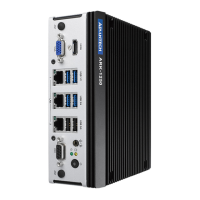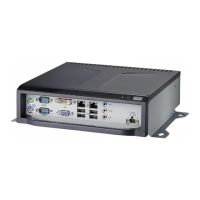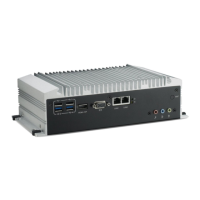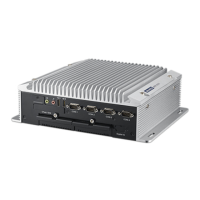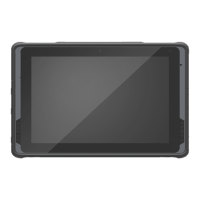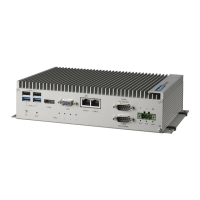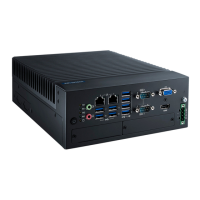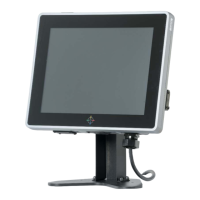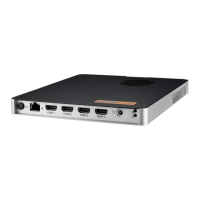Do you have a question about the Advantech ARK-1550 and is the answer not in the manual?
Provides an overview of the ARK-1550 Fanless Embedded Box PC.
Details the key features, graphics capabilities, and power consumption.
Lists the main capabilities and specifications of the ARK-1550 system.
Details the graphics chipset, engine, and supported display outputs.
Provides power usage figures for different operational states.
Outlines the core hardware components and their capabilities.
Details the physical dimensions and weight of the unit.
Specifies the physical size of the ARK-1550 unit.
Indicates the weight of the ARK-1550 unit.
Details the required DC power input for the system.
Describes the specifications of the Real-Time Clock battery.
Details operating and storage environmental conditions.
Specifies the temperature range for system operation.
Defines the acceptable humidity levels for operation.
Specifies the temperature range for storing the unit.
Details the vibration resistance specifications during operation.
Details the shock resistance specifications during operation.
Lists the safety certifications and standards the device complies with.
Lists the Electromagnetic Compatibility certifications.
Sections show internal jumper settings and external connectors/pin assignments.
Details internal jumpers for system configuration.
Identifies the internal jumpers and their functions for system configuration.
Explains how to configure jumpers to set system options.
Provides an overview of the input/output ports on the device.
Details all external input/output connectors on the ARK-1550.
Describes the function of the system's power button.
Details the DC power input connector and its mounting.
Explains the RJ45 LAN ports and their specifications.
Details the D-sub VGA output port and its resolution capabilities.
Describes the available USB ports (2.0 and 3.0) and their functionality.
Details the stereo audio ports for line-out, mic-in, and line-in.
Describes the D-sub serial communication ports (RS-232, RS-422/485).
Details the 8-bit Digital Input/Output connector.
Describes the lockable HDMI port and its resolution support.
Explains the front panel LEDs for power and HDD status.
Details the LVDS output connector for LCD displays.
Describes the connector for LCD backlight control.
Instructions for installing optional hardware components.
Provides instructions for installing system memory.
Details the procedure for installing a 2.5" SATA HDD.
Explains how to install an mSATA storage device.
Describes the installation of wireless modules.
Introduces the AMIBIOS Setup program for system configuration.
Explains how to access the BIOS setup menu.
Navigates the primary BIOS configuration screen.
Accesses advanced system configuration options.
Configures PCI and PCI Express related settings.
Manages advanced PCI Express link configurations.
Configures power management and ACPI features.
Manages BIOS support for security devices.
Configures system wake-up using the Real-Time Clock.
Adjusts various CPU-related settings and features.
Configures SATA controllers and drive settings.
Manages Intel's Rapid Start Technology.
Configures Intel Active Management Technology settings.
Manages Platform Controller Hub firmware settings.
Configures USB controller and port settings.
Adjusts settings related to the embedded controller.
Configures settings for Super I/O devices.
Configures serial port redirection for system management.
Accesses chipset-specific BIOS configuration options.
Configures settings for the System Agent.
Manages Intel integrated graphics settings.
Configures LCD display and panel settings.
Displays and potentially configures memory parameters.
Configures Platform Controller Hub I/O device settings.
Manages PCI Express root port and link settings.
Configures USB controller and port settings.
Configures audio device settings.
Configures system boot order and related options.
Manages system passwords and security features.
Handles saving configuration changes and exiting the BIOS setup.
Provides example code for implementing the watchdog timer functionality.
Provides an overview of the ARK-1550 Fanless Embedded Box PC.
Details the key features, graphics capabilities, and power consumption.
Lists the main capabilities and specifications of the ARK-1550 system.
Details the graphics chipset, engine, and supported display outputs.
Provides power usage figures for different operational states.
Outlines the core hardware components and their capabilities.
Details the physical dimensions and weight of the unit.
Specifies the physical size of the ARK-1550 unit.
Indicates the weight of the ARK-1550 unit.
Details the required DC power input for the system.
Describes the specifications of the Real-Time Clock battery.
Details operating and storage environmental conditions.
Specifies the temperature range for system operation.
Defines the acceptable humidity levels for operation.
Specifies the temperature range for storing the unit.
Details the vibration resistance specifications during operation.
Details the shock resistance specifications during operation.
Lists the safety certifications and standards the device complies with.
Lists the Electromagnetic Compatibility certifications.
Sections show internal jumper settings and external connectors/pin assignments.
Details internal jumpers for system configuration.
Identifies the internal jumpers and their functions for system configuration.
Explains how to configure jumpers to set system options.
Provides an overview of the input/output ports on the device.
Details all external input/output connectors on the ARK-1550.
Describes the function of the system's power button.
Details the DC power input connector and its mounting.
Explains the RJ45 LAN ports and their specifications.
Details the D-sub VGA output port and its resolution capabilities.
Describes the available USB ports (2.0 and 3.0) and their functionality.
Details the stereo audio ports for line-out, mic-in, and line-in.
Describes the D-sub serial communication ports (RS-232, RS-422/485).
Details the 8-bit Digital Input/Output connector.
Describes the lockable HDMI port and its resolution support.
Explains the front panel LEDs for power and HDD status.
Details the LVDS output connector for LCD displays.
Describes the connector for LCD backlight control.
Instructions for installing optional hardware components.
Provides instructions for installing system memory.
Details the procedure for installing a 2.5" SATA HDD.
Explains how to install an mSATA storage device.
Describes the installation of wireless modules.
Introduces the AMIBIOS Setup program for system configuration.
Explains how to access the BIOS setup menu.
Navigates the primary BIOS configuration screen.
Accesses advanced system configuration options.
Configures PCI and PCI Express related settings.
Manages advanced PCI Express link configurations.
Configures power management and ACPI features.
Manages BIOS support for security devices.
Configures system wake-up using the Real-Time Clock.
Adjusts various CPU-related settings and features.
Configures SATA controllers and drive settings.
Manages Intel's Rapid Start Technology.
Configures Intel Active Management Technology settings.
Manages Platform Controller Hub firmware settings.
Configures USB controller and port settings.
Adjusts settings related to the embedded controller.
Configures settings for Super I/O devices.
Configures serial port redirection for system management.
Accesses chipset-specific BIOS configuration options.
Configures settings for the System Agent.
Manages Intel integrated graphics settings.
Configures LCD display and panel settings.
Displays and potentially configures memory parameters.
Configures Platform Controller Hub I/O device settings.
Manages PCI Express root port and link settings.
Configures USB controller and port settings.
Configures audio device settings.
Configures system boot order and related options.
Manages system passwords and security features.
Handles saving configuration changes and exiting the BIOS setup.
Provides example code for implementing the watchdog timer functionality.
| Chassis type | - |
|---|---|
| Product color | Black, Silver |
| Water cooling system | No |
| Bus type | DMI2 |
| Stepping | D0 |
| Tjunction | 100 °C |
| Processor cache | 3 MB |
| Processor cores | 2 |
| Processor model | i5-4300U |
| System bus rate | 5 GT/s |
| Processor family | 4th gen Intel® Core™ i5 |
| Processor series | Intel Core i5-4300 Mobile series |
| Processor socket | BGA 1168 |
| Processor threads | 4 |
| Processor codename | Haswell |
| Processor frequency | 1.9 GHz |
| Processor cache type | Smart Cache |
| Processor lithography | 22 nm |
| Conflict-Free processor | Yes |
| Processor front side bus | - MHz |
| PCI Express slots version | 2.0 |
| Processor boost frequency | 2.9 GHz |
| Processor operating modes | 64-bit |
| PCI Express configurations | 4x1, 2x4 |
| Thermal Design Power (TDP) | 15 W |
| Number of processors installed | 1 |
| Maximum number of PCI Express lanes | 12 |
| Memory types supported by processor | DDR3L-SDRAM |
| Memory clock speeds supported by processor | 1333, 1600 MHz |
| Memory bandwidth supported by processor (max) | 25.6 GB/s |
| Maximum internal memory supported by processor | 16 GB |
| Certification | CE/FCC Class A, CCC, BSMI, UL, CCC, BSMI, CB |
| Memory slots | 1x SO-DIMM |
| Internal memory | 8 GB |
| Memory channels | Dual-channel |
| Memory clock speed | 1600 MHz |
| Internal memory type | DDR3-SDRAM |
| Memory layout (slots x size) | 1 x 8 GB |
| HDD size | 2.5 \ |
| HDD interface | SATA |
| Total storage capacity | 0 GB |
| Serial ports quantity | 3 |
| USB 2.0 ports quantity | USB 2.0 ports have a data transmission speed of 480 Mbps, and are backwards compatible with USB 1.1 ports. You can connect all kinds of peripheral devices to them. |
| USB 3.2 Gen 2 (3.1 Gen 2) Type-A ports quantity | 0 |
| Cabling technology | 10/100/1000Base-T(X) |
| Ethernet LAN data rates | 10, 100, 1000 Mbit/s |
| Compatible operating systems | Windows 7, 8 Linux |
| On-board graphics card ID | 0xA16 |
| Discrete graphics card model | Not available |
| On-board graphics card model | Intel® HD Graphics 4400 |
| On-board graphics card family | Intel® HD Graphics |
| Maximum on-board graphics card memory | 1.74 GB |
| On-board graphics card base frequency | 200 MHz |
| On-board graphics card dynamic frequency (max) | 1100 MHz |
| Cover material | Aluminum |
| BIOS type | UEFI AMI |
| Audio system | HD |
| Product type | Embedded PC |
| Motherboard southbridge | Intel ICH8M |
| Storage temperature (T-T) | -40 - 85 °C |
| Operating temperature (T-T) | 0 - 40 °C |
| Operating relative humidity (H-H) | 0 - 95 % |
| Power supply input voltage | 12 V |
| Processor code | SR1ED |
| Processor ARK ID | 76308 |
| Intel TSX-NI version | 0.00 |
| Processor package size | 40 mm |
| Intel ME Firmware Version | 9.5 |
| Supported instruction sets | AVX 2.0, SSE4.1, SSE4.2 |
| Intel Smart Connect Technology version | 1.00 |
| Depth | 133 mm |
|---|---|
| Width | 223 mm |
| Height | 46.6 mm |
| Weight | - g |

